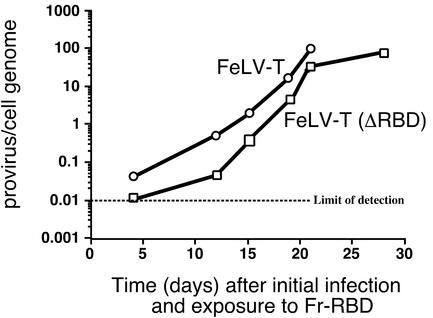FIG. 8.
Transactivation is sufficient for FeLV-T replication and pathogenesis. Human 293-mCAT1 cells were exposed to either FeLV-T or FeLV-T in which RBD had been deleted from the virus envelope glycoprotein (FeLV-T [ΔRBD]) and cultured in the continuous presence of Fr-RBD in the medium (20 nM). Cells were passaged every 3 or 4 days, and Fr-RBD was replaced. Cells were inspected for virus-induced cell-cell fusion, and the experiment was stopped when >95% of cells were present in large syncytia that did not survive passage (day 21 for FeLV-T and day 28 for FeLV-T [ΔRBD]). At intervals after initial infection, cell DNA was prepared and used as a template for quantitative PCR measurement of acquired FeLV-T proviruses by using specific primers derived from the FeLV-T gag gene. These measurements were calibrated against a standard curve obtained by spiking 293mCAT1 cell DNA with a linear plasmid containing the FeLV-T provirus plasmid, EECC, at calculated concentrations of 0.01, 0.1, 1, 10, and 100 copies/haploid genome. The number of FeLV-T proviruses per 293mCAT1 cell haploid genome is shown (average of triplicate measurements from a single experiment) as a function of number of days after initial exposure to FeLV-T. The lower limit of FeLV-T provirus detection is 0.01 copy per haploid genome.

